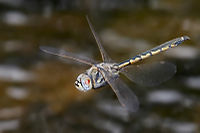
Photo from wikipedia
EDITOR'S RECOMMENDATION The flight of insects has enlightened the flying dream of human beings for centuries. Wing flexibility is often used by insects to increase their flight efficiencies. However, the… Click to show full abstract
EDITOR'S RECOMMENDATION The flight of insects has enlightened the flying dream of human beings for centuries. Wing flexibility is often used by insects to increase their flight efficiencies. However, the mechanism of the increased efficiencies still remains mysterious. Prof. Kai Schneider's group studies the aerodynamics of a tethered flapping bumblebee using a mass-spring fluid-structure interaction numerical solver. It indicates that a higher flight efficiency or a larger lift-to-power ratio can be achieved by flapping insects with optimal mechanical properties of the flexible wings. The novel understanding of insects’ body structure and flying behavior will benefit the design of micro-air vehicles (MAVs). ABSTRACT The sophisticated structures of flapping insect wings make it challenging to study the role of wing flexibility in insect flight. In this study, a mass-spring system is used to model wing structural dynamics as a thin, flexible membrane supported by a network of veins. The vein mechanical properties can be estimated based on their diameters and the Young's modulus of cuticle. In order to analyze the effect of wing flexibility, the Young's modulus is varied to make a comparison between two different wing models that we refer to as flexible and highly flexible. The wing models are coupled with a pseudo-spectral code solving the incompressible Navier–Stokes equations, allowing us to investigate the influence of wing deformation on the aerodynamic efficiency of a tethered flapping bumblebee. Compared to the bumblebee model with rigid wings, the one with flexible wings flies more efficiently, characterized by a larger lift-to-power ratio.
Journal Title: Theoretical and Applied Mechanics Letters
Year Published: 2020
Link to full text (if available)
Share on Social Media: Sign Up to like & get
recommendations!